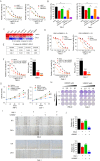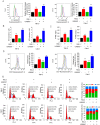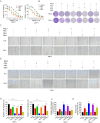Combination treatment with FAAH inhibitors/URB597 and ferroptosis inducers significantly decreases the growth and metastasis of renal cell carcinoma cells via the PI3K-AKT signaling pathway
- PMID: 37024452
- PMCID: PMC10079857
- DOI: 10.1038/s41419-023-05779-z
Combination treatment with FAAH inhibitors/URB597 and ferroptosis inducers significantly decreases the growth and metastasis of renal cell carcinoma cells via the PI3K-AKT signaling pathway
Abstract
Ferroptosis, a nonapoptotic form of programmed cell death characterized by significant iron-dependent peroxidation of phospholipids, is regulated by cellular metabolism, redox homeostasis, and various cancer-related signaling pathways. Recently, considerable progress has been made in demonstrating the critical role of lipid metabolism in regulating ferroptosis, indicating the potential of combinational strategies for treating cancer in the future. In this study, we explored the combinational effects of lipid metabolism compounds and ferroptosis inducers on renal cell carcinoma (RCC) cells. We found potent synergy of the fatty acid amide hydrolase (FAAH) inhibitor URB597 with ferroptosis inducer (1S, 3R)-RSL3 (RSL3) in inhibiting the growth and metastasis of RCC cells both in vitro and in vivo via induction of G1 cell cycle arrest and promotion of the production of lipid peroxides, malondialdehyde (MDA), 4-hydroxynonenal (4-HNE), and cytosolic reactive oxygen species (ROS). In addition, inhibition of FAAH increased the sensitivity of RCC cells to ferroptosis. Genome-wide RNA sequencing indicated that the combination of URB597 and RSL3 has more significant effects on regulation of the expression of genes related to cell proliferation, the cell cycle, cell migration and invasion, and ferroptosis than either single agent alone. Moreover, we found that combinational treatment modulated the sensitivity of RCC cells to ferroptosis via the phosphatidylinositol 3 kinase (PI3K)-AKT signaling pathway. These data demonstrate that dual targeting of FAAH and ferroptosis could be a promising strategy for treating RCC.
© 2023. The Author(s).
Conflict of interest statement
The authors declare no competing interests.
Figures







Similar articles
-
Inhibition of cannabinoid receptor type 1 sensitizes triple-negative breast cancer cells to ferroptosis via regulating fatty acid metabolism.Cell Death Dis. 2022 Sep 21;13(9):808. doi: 10.1038/s41419-022-05242-5. Cell Death Dis. 2022. PMID: 36130940 Free PMC article.
-
Everolimus accelerates Erastin and RSL3-induced ferroptosis in renal cell carcinoma.Gene. 2022 Jan 30;809:145992. doi: 10.1016/j.gene.2021.145992. Epub 2021 Oct 11. Gene. 2022. PMID: 34648917
-
Galangin inhibited ferroptosis through activation of the PI3K/AKT pathway in vitro and in vivo.FASEB J. 2022 Nov;36(11):e22569. doi: 10.1096/fj.202200935R. FASEB J. 2022. PMID: 36183339
-
The PI3K/AKT Pathway and Renal Cell Carcinoma.J Genet Genomics. 2015 Jul 20;42(7):343-53. doi: 10.1016/j.jgg.2015.03.003. Epub 2015 Mar 19. J Genet Genomics. 2015. PMID: 26233890 Free PMC article. Review.
-
Targeting Ferroptosis Pathways: A Novel Strategy for Cancer Therapy.Curr Cancer Drug Targets. 2022;22(3):234-244. doi: 10.2174/1568009622666220211122745. Curr Cancer Drug Targets. 2022. PMID: 35152865 Review.
Cited by
-
Serum apolipoprotein H determines ferroptosis resistance by modulating cellular lipid composition.Cell Death Dis. 2024 Oct 1;15(10):718. doi: 10.1038/s41419-024-07099-2. Cell Death Dis. 2024. PMID: 39353906 Free PMC article.
-
Advances in Ferroptosis Research: A Comprehensive Review of Mechanism Exploration, Drug Development, and Disease Treatment.Pharmaceuticals (Basel). 2025 Feb 26;18(3):334. doi: 10.3390/ph18030334. Pharmaceuticals (Basel). 2025. PMID: 40143112 Free PMC article. Review.
-
Interference with ENO2 promotes ferroptosis and inhibits glycolysis in clear cell renal cell carcinoma by regulating Hippo‑YAP1 signaling.Oncol Lett. 2024 Jul 19;28(3):443. doi: 10.3892/ol.2024.14576. eCollection 2024 Sep. Oncol Lett. 2024. PMID: 39091581 Free PMC article.
-
The mechanism of ferroptosis and its related diseases.Mol Biomed. 2023 Oct 16;4(1):33. doi: 10.1186/s43556-023-00142-2. Mol Biomed. 2023. PMID: 37840106 Free PMC article. Review.
-
Polygonum multiflorum Stilbene Glycoside Oligomers induce the ferroptosis of triple negative breast cancer cells.BMC Cancer. 2025 Apr 14;25(1):676. doi: 10.1186/s12885-025-13999-z. BMC Cancer. 2025. PMID: 40229746 Free PMC article.
References
Publication types
MeSH terms
Substances
LinkOut - more resources
Full Text Sources
Medical

